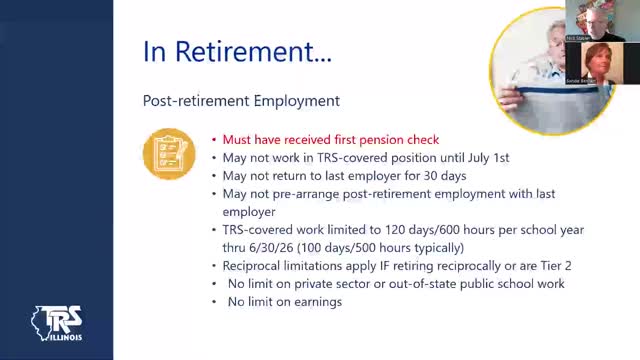TRS warns retirees on post-retirement work limits and rules
January 01, 2025 | Teachers' Retirement System Board of Trustees, T, Boards and Commissions, Executive, Illinois
This article was created by AI summarizing key points discussed. AI makes mistakes, so for full details and context, please refer to the video of the full meeting. Please report any errors so we can fix them. Report an error »

TRS outreach staff outlined the statutory and temporary rules that govern returning to TRS‑covered employment after retirement.
Nick Stabler said retirees must receive their first TRS pension payment before they can be considered retired for TRS purposes and before resuming TRS‑covered employment.
“You must be in receipt of your first TRS pension check or direct deposit from TRS in order to be considered retired,” Stabler said. TRS also noted an IRS rule requiring a 30‑day break from the last employer to secure retiree tax status.
On post‑retirement work limits, Stabler described the statutory baseline and the temporary extension in effect: the permanent law provides a 100‑day / 500‑hour limit per school year, but TRS is operating under a legislative extension that allows 120 days or 600 hours per school year through June 30, 2026. TRS counts any day of five or more hours as a full day and counts hours for days under five hours.
Stabler cautioned that members who retired reciprocally (for example, combined TRS and IMRF service credit) must also observe the post‑retirement limits of the other system; exceeding limits can suspend or revoke pension payments until the member re‑retires and may require repayment of benefits.
Tier 2 retirees face an additional constraint: under law a Tier 2 annuitant cannot return to full‑time public employment in any reciprocal system. TRS advised members not to sign written post‑retirement employment agreements with their last employer before receiving the first pension payment.
TRS urged members to call with questions before accepting post‑retirement work to avoid unwinding a retirement claim and repaying benefits.
Nick Stabler said retirees must receive their first TRS pension payment before they can be considered retired for TRS purposes and before resuming TRS‑covered employment.
“You must be in receipt of your first TRS pension check or direct deposit from TRS in order to be considered retired,” Stabler said. TRS also noted an IRS rule requiring a 30‑day break from the last employer to secure retiree tax status.
On post‑retirement work limits, Stabler described the statutory baseline and the temporary extension in effect: the permanent law provides a 100‑day / 500‑hour limit per school year, but TRS is operating under a legislative extension that allows 120 days or 600 hours per school year through June 30, 2026. TRS counts any day of five or more hours as a full day and counts hours for days under five hours.
Stabler cautioned that members who retired reciprocally (for example, combined TRS and IMRF service credit) must also observe the post‑retirement limits of the other system; exceeding limits can suspend or revoke pension payments until the member re‑retires and may require repayment of benefits.
Tier 2 retirees face an additional constraint: under law a Tier 2 annuitant cannot return to full‑time public employment in any reciprocal system. TRS advised members not to sign written post‑retirement employment agreements with their last employer before receiving the first pension payment.
TRS urged members to call with questions before accepting post‑retirement work to avoid unwinding a retirement claim and repaying benefits.
View full meeting
This article is based on a recent meeting—watch the full video and explore the complete transcript for deeper insights into the discussion.
View full meeting
